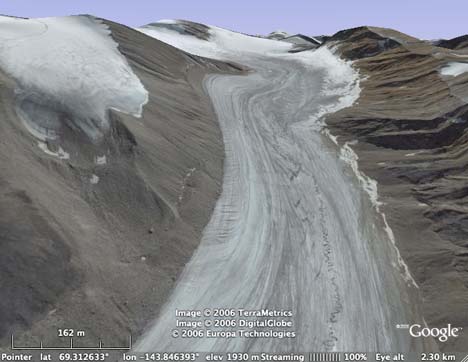University of Alaska Fairbanks’ Matt Nolan has produced an online video that uses his research on Alaska’s McCall Glacier to explain the anatomy of a glacier and how glaciologists do their work. It had me watching with rapt attention. I don’t think I’ve ever learned so much about glaciers in so little time.
The video sets the bar for how virtual globes can be used as presentation tools. It also shows off nicely the abilities of EarthSLOT, a free virtual globe that Matt developed using Skyline’s TerraExplorer technology, and which he could thus customize with height mesh data that has a higher accuracy than Google Earth’s for the region:


But the video also whets the appetite for how virtual globes could and should be used as presentation tools, because what we really want to do is view such presentations in the virtual globe itself, with a scripted camera, a voiceover track, and layers or objects that load and unload at the appropriate time. Matt’s EarthSLOT has some of this functionality built in — you can download some components of the tour in the middle of this page (though without voice, for example: Matt added that in post-production for the video.)
Soon, conceivably, such a presentation might be delivered via a KML file that plays in Google Earth or a KML-compatible virtual globe. And when you’re done with the presentation, the contents of the KML file would be available as layers for you to explore at your leisure.
Such virtual globe presentation technology would be useful for much more than just science presentations. You could give guided tours of SketchUp houses or city neighborhoods, narrate your travels, or re-enact historical battles.
Bottom-line Virtual maps are just too cool for their own good. Being able to view 3-D environment in such detail just is really going to revolutionize travel in so many ways.